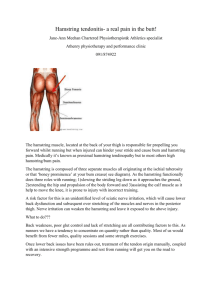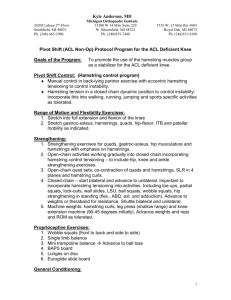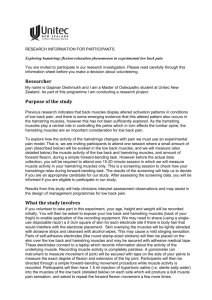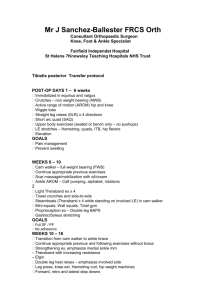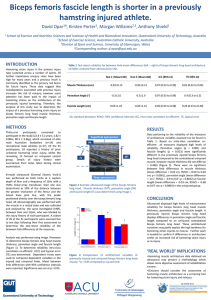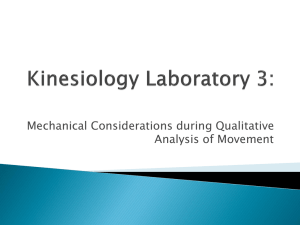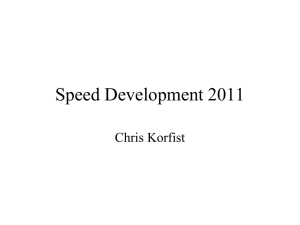Hamstring Information Sheet
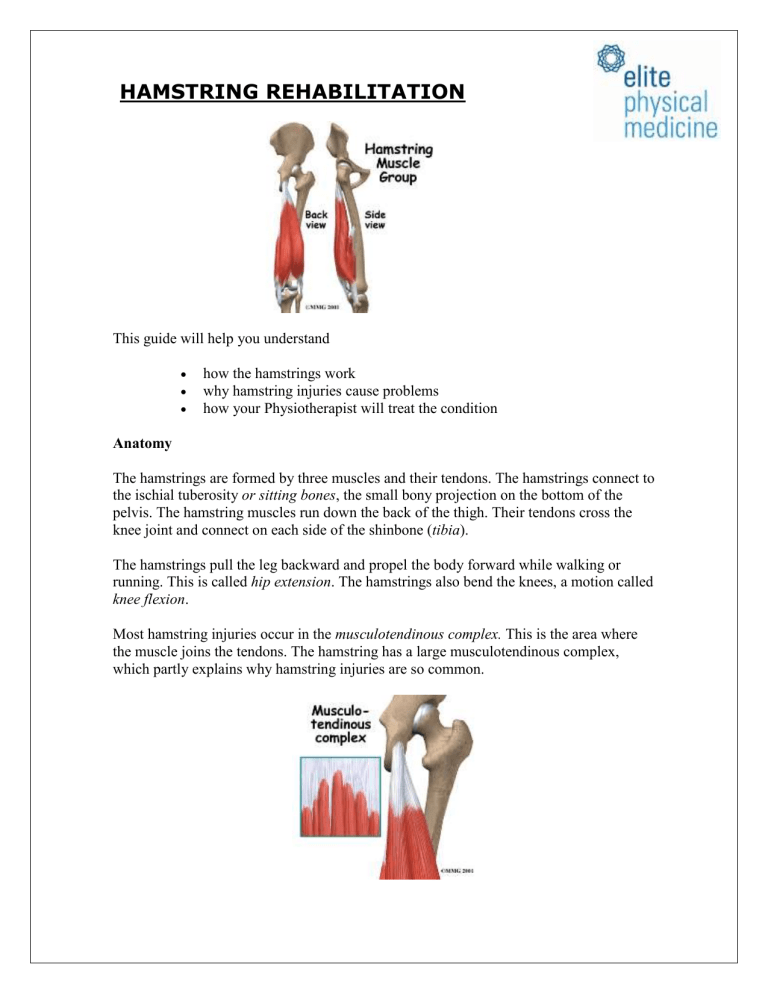
HAMSTRING REHABILITATION
This guide will help you understand
how the hamstrings work
why hamstring injuries cause problems how your Physiotherapist will treat the condition
Anatomy
The hamstrings are formed by three muscles and their tendons. The hamstrings connect to the ischial tuberosity or sitting bones , the small bony projection on the bottom of the pelvis. The hamstring muscles run down the back of the thigh. Their tendons cross the knee joint and connect on each side of the shinbone ( tibia ).
The hamstrings pull the leg backward and propel the body forward while walking or running. This is called hip extension . The hamstrings also bend the knees, a motion called knee flexion .
Most hamstring injuries occur in the musculotendinous complex.
This is the area where the muscle joins the tendons. The hamstring has a large musculotendinous complex, which partly explains why hamstring injuries are so common.
When the hamstring is injured, the fibers of the muscles or tendon are torn.
The body responds to the damage by producing enzymes and other body chemicals at the site of the injury which cause swelling and pain.
In a severe injury, the small blood vessels in the muscle can be torn as well resulting in bleeding into the muscle tissue. Until these small blood vessels can repair themselves, less blood can flow to the area. With this reduced blood flow, the muscles cannot begin to heal.
In rare cases, an injury can cause the muscle and tendons to tear away from the bone.
This happens most often where the hamstring tendons attach to the ischial tuberosity.
These tears, called avulsions, sometimes require surgery.
Causes
Injury happens when the muscle is stretched too far. Sprinting and other fast or twisting motions with the legs are the major cause of hamstring injuries. The major factors in hamstring injuries are low levels of fitness and poor flexibility. Muscle fatigue and not warming up properly can contribute to hamstring injuries.
Imbalances in the strength of different leg muscles can lead to hamstring injuries. The hamstring muscles of one leg may be much stronger than the other leg, or the quadriceps muscles on the front of the thigh may overpower the hamstrings. Poor Core stability recently has been closely linked to repeated hamstring strains/tears.
Symptoms
In severe cases an athlete may suddenly hear a pop and fall to the ground. The athlete may be able to walk with only mild pain even in a severe injury. But taking part in strenuous exercise will be impossible, and the pain will continue.
In less severe cases, athletes notice a tight feeling or a pulling in their hamstring that slows them down. This type of hamstring injury often turns into a longlasting problem.
Diagnosis
There will be a detailed medical history that includes questions about your exercise schedule, your activities, and the way you warm up. You will also need to describe your symptoms.
Sports Physiotherapists group hamstring injuries into three categories:
Grade one - mild damage to the tissues.
Grade two – moderate / partial tear
Grade three – severe. Complete tears.
Treatment
Nonsurgical Treatment
It is very important to treat and rehabilitate your hamstring injury correctly. Incomplete or improper healing makes re-injury much more likely.
For the first 3 to 5 days after the injury, the main goal of treatment is to control the swelling, pain, and hemorrhage (bleeding). Hamstring injuries are initially treated using the RICE method.
RICE stands for Rest, Ice, Compression, and Elevation.
Medication
Your doctor may also prescribe a short course of nonsteroidal anti-inflammatory drugs , such as ibuprofen, to help relieve the swelling and pain. Doctors disagree on when to give
NSAIDs. Some think you should start using them right after the injury and stop using them after 3 to 5 days. Others think you should not use them for 2 to 4 days so you don't interrupt your body's natural healing response. The inflammation is an important part of your body's work to heal your injury.
Surgery may be needed to repair a complete tear of a hamstring muscle. An incision is made over the back of the thigh where the hamstring muscle is torn. The muscle repair involves reattaching the two torn ends and sewing them together.
HAMSTRING REHABILITATION PROTOCOL
• This programme is designed as a guide for rehabilitation
• The time frames for various sections will be dependant upon the degree of injury
• All exercises should be pain free. This is the best guide for progression
• When you can complete one stage of the exercise regime in a pain free fashion, you can progress to the next level. If you are in any doubt, consult Elite Physical Medicine
Day 1-4 Post Injury
1.
RICE
Sit with an ice bag underneath the injured area of the hamstrings while performing gentle
Range of Motion (ROM) exercises to obtain full ROM. Keep bending and straightening the knee to the point of mild discomfort only.
REPETITIONS:
SETS:
Day 4-7 Post Injury
2. MOBILIZE THE HAMSTRING THROUGH FULL RANGE
Lie on your back with your hip bent to 90 degrees and your hands supporting behind your thigh. Hold this position and gently straighten the knee until you feel a stretch at the back of the thigh.
HOLD THIS FOR COUNT OF
10 RELAX AND REPEAT 5
TIMES.
3.
MOBILIZE THE NERVE TISSUE
Repeat the above exercise for mobilizing your hamstring but perform the exercise with the foot flexed. Once you have done this 10 times, hold the knee as straight as possible and point and flex the foot 10 times.
4.. COMMENCE GENTLE STRENGTHENING WORK
•
When progressing strength work, pain should always be used as a guideline for progression
• All exercises should be performed in a pain free fashion
BASIC STRENGTH WORK
Begin this hamstring strengthening exercise in sitting with your knee bent to about 45 degrees. Press your heel into the floor tightening the back of your thigh (hamstrings).
HOLD FOR 5 SECONDS
REPEAT 10 TIMES AS HARD AS
POSSIBLE PAIN FREE.
INTERMEDIATE STRENGTH WORK
BRIDGING
Begin this hamstring strengthening exercise lying on your back in the position demonstrated. Slowly lift your bottom pushing through your feet, until your knees, hips and shoulders are in a straight line.
Tighten the back of your thigh
(hamstrings) as you do this.
HOLD FOR 2 SECONDS THEN
SLOWLY LOWER YOUR
BOTTOM BACK DOWN.
REPEAT 10 TIMES.
Begin this hamstring strengthening exercise lying on your stomach with a resistance band tied around your ankle as shown. Slowly bend your knee tightening the back of your thigh
(hamstrings).
3 SETS
10 REPETITIONS (PROVIDED THE
EXERCISE IS PAIN FREE.
HAMSTRING CURLS
HIP EXTENSION WITH RESISTANCE BAND
Begin this hamstring strengthening exercise standing at a bench or chair for balance and a resistance band around your ankle as demonstrated. Keeping your back and knee straight, slowly take your leg backwards tightening the back of your thigh (hamstrings).
Then slowly return the leg back to the starting position.
3 SETS OF 10 REPETITIONS AS FAR AS
POSSIBLE PROVIDED IT IS PAIN-FREE.
ADVANCED HAMSTRING STRENGTHENING
HAMSTRING CURLS ON SWISS BALL
Begin this hamstring strengthening exercise lying on your back with a Swiss ball under your legs as demonstrated. Keeping your back straight, slowly bend your knees tightening the back of your thighs (hamstrings). Then return to the starting position.
PERFORM 3 SETS OF 10 REPETITIONS
PROVIDED THE EXERCISE IS PAIN
FREE. ONCE THIS IS TOO EASY, THE
EXERCISE CAN BE PERFORMED ON
EACH LEG INDIVIDUALLY AS SHOWN
BELOW
Hamstring Curls on Swiss Ball Single Leg (right)
SINGLE LEG BRIDGING
Begin this hamstring strengthening exercise lying on your back in the position demonstrated. Slowly lift your bottom pushing through your foot, until your knee, hip and shoulder are in a straight line.
Tighten the back of your thigh (hamstrings) as you do this and hold for 2 seconds. Then slowly lower back down.
PERFORM 3 SETS OF 10 REPETITIONS
PROVIDED IT IS PAIN FREE.
ECCENTRIC STRENGTHENING / NORDIC HAMSTRING
EXERCISES
It is important to strengthen the hamstring muscles eccentrically (as they lengthen) as this is when they are most commonly injured. This is a very advanced exercise and should only be performed when the injury has healed and earlier strength training has been progressed.
REPS:
This exercise can be done using gym equipment, a rehabilitation band or ankle weights. Lying on the front with the knee straight, the leg is bent slowly, bringing the heel towards the buttocks. Slowly straighten the leg again in one smooth movement, controlling the downward force.
Starting in a kneeling position with the feet and ankles firmly fixed, lean forwards and aim to resist the downwards movement. Ensure you keep the back straight and do not pivot at the hips. Slowly lower yourself down towards the floor (or couch). As you move lower, use your hands to safely lower your body down before pushing back up to the starting position. As your hamstrings become stronger you will be able to lower yourself with more control.
SETS:
LEG CURL
SETS: REPS: WEIGHT:
This exercise can also be altered to work the muscle ECCENTRICALLY. In this case you bend your good luck up but focus the lowering only through your injured leg. Only do this is told to do so by your physio.
SETS: REPS: WEIGHT:
FUNCTIONAL REHABILITATION
Maintain CV Fitness
Cycling
Swimming
Pool running
Walking on incline
You can also introduce general functional exercises some examples are shown below:
BALL SQUATS FREE SQUATS
TYPE OF SQUAT:
REPS:
SETS:
HOLD:
SINGLE LEG SQUAT LUNGES
REPS:
SETS:
REPS:
SETS:
STEP UPS
REPS:
SETS:
HAMSTRING STRETCHES
STATIC STRETCHES
DYNAMIC STRETCHES
(PNF) PROPRIOCEPTIVE NEUROMUSCULAR FACILITATION
Contract - Push against resistance with a straight leg at 50% effort. The resistance must be great enough so that the leg cannot move. Hold for 10 seconds
Relax and pull the leg up keeping it straight with the quadriceps muscles at the front of the legs ( agonist ).Repeat the process until no more gains are possible ( contract ).
KEEP THE LEG STRAIGHT.
REPETITIONS: SETS: LENGTH OF HOLD:
RETURN TO JOGGING AND SPORT
Once you are able to do the following pain-free:
Walk
Perform resisted hamstring contractions against the theraband exercise tubing
Straighten the knee to extend the hamstring muscle fully
You then need to ensure that you can:
MAINTAIN full hamstring extensibility, BUT DO NOT FORCE A STRETCH
MAINTAIN full mobility of the nerve structures
MAINTAIN CV Fitness
The Running Programme Remember this is only a guide please discuss with your physiotherapist before attempting this.
Place 4 cones so that a distance of 100m is broken into the following zones:
Commence at 70% of maximum pace
40m 20m 40m
Build up to 70% Maintain 70% speed Decelerate down
Run through the distance and then walk back to the starting cone
Do 2 run through at this distance and then, if this is pain free – bring the cones in by 5m.
Do 2 run through at each distance, pausing between every 6 (3 sets) for a 5min break.
Continue this process until you become ‘aware’ of your hamstring. Cease exercising for the day at this point. When you recommence the following day, you need to return to the start of the programme and work through it until you again become ‘aware’ of the muscle.
Once you have reduced the acceleration/ deceleration phases to 5metres, repeat the entire process at 90% of maximum pace, and then again at 100%.
This programme should be repeated on a 2 days on / 1 day off basis.
You are ready to recommence training once you can:
Complete the running programme Run forwards and backwards
Run up and down hills
Jump and hop
Slow down and stop suddenly
Cut left and right
Complete all exercises with 100% confidence
FINAL THOUGHT
CONFIDENCE IN THE ABILITY OF YOUR HAMSTRING TO WITHSTAND THE
RIGORS OF PLAYING IS ABSOLUTELY ESSENTIAL FOR A HASSLE FREE RETURN
TO COMPETITION
